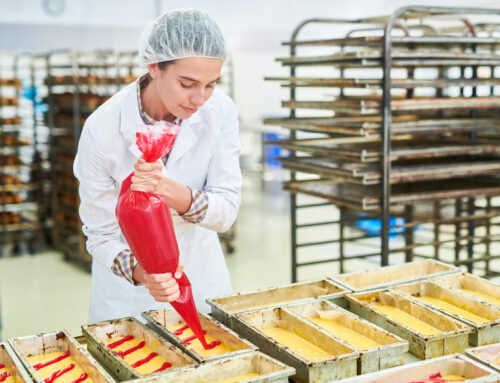For companies in the food manufacturing industry, adhering to hygiene standards is perhaps one of the greatest responsibilities that an organization has. Neglecting food industry standards around hygiene in your facility is a literal recipe for disaster.
According to the Center for Disease Control (CDC) estimates, approximately 48 million people get sick from food borne illness each year. Of that number, 128,000 are hospitalized, and 3,000 die each year in the United States.
Clearly, food safety in manufacturing is an issue that you cannot take lightly. Today, we’ll take a close look at what exactly is food hygiene and safety in a manufacturing context, as well as best practices and steps you can take to ensure that your facility is prepared to take food safety in manufacturing seriously.

What is Food Hygiene and Safety?
Food hygiene and safety is a broad topic that covers the myriad of policies and procedures that manufacturing organizations use to protect their products and customers against food borne illness and disease. To better understand the concept, we’ll narrow things down a bit.
What is Food Hygiene?
Food hygiene is the specific set of practices that food manufacturing organizations implement to protect food products from contamination throughout the supply chain. It is an action-oriented approach at each step in the supply chain that focuses on the everyday tasks of keeping food products safe.
Because food products are at constant risk from becoming contaminated with bacteria, viruses, chemicals, and other contaminants, food hygiene standards are essential to keeping products safe for human consumption and preventing food-borne illness from spreading.
Some key aspects of food hygiene include:
Safe Food Handling
Safe food handling includes practices like keeping raw foods from coming into contact with cooked foods, using separate utensils for different food varieties, and utilizing proper cooking times during food preparation.
Personal Hygiene
More than just handwashing, personal hygiene includes keeping clothes clean, as well as keeping hair tied back. Jewelry and nail polish should also be kept away from food-handling areas.
Storage and Transportation
When food is being stored and transported, it is essential that it is stored at the proper temperatures in order to prevent bacteria growth and spoilage.
What is Food Safety?
Where food hygiene refers to the physical practices of keeping free from contamination, the concept of food safety describes the broader systems put in place to keep food supplies safe to eat.
Some examples of food safety in manufacturing include:
Government Regulations
Various food industries are subject to regulations imposed by the federal government. For example, the U.S. Food and Drug Administration enacts a set of regulations known as Current Good Manufacturing Practices (CGMPs) that serve as guidelines for a variety of food safety practices.
Hazard Analysis and Critical Control Points (HACCP)
HACCPs are a technique used to identify and control potential health hazards throughout a supply chain. An HACCP team will identify all potential hazard points in your production process, as well as establish checkpoints to monitor safety. Limits are established to determine if a product is safe or hazardous.
Why are Good Hygiene Practices in the Food Industry So Important?
Practicing good food hygiene and safety is important for many reasons. Some of the most prominent benefits of maintaining food hygiene standards include:
Keeping Consumers Safe from Foodborne Illness
Food industry standards exist because the threat of contamination is ever present throughout the food chain. Some of the most common foodborne illnesses that can result from poor hygiene include:
Salmonella
A bacterial infection most commonly found in poultry, eggs, and dairy products, which can be particularly dangerous for children, elderly, or those with weakened immune systems.
E. coli
Some strains of E. coli can contaminate food such as beef, milk, and unpasteurized dairy products, causing diarrhea, nausea, and vomiting.
Campylobacteriosis
A bacterial infection that can affect undercooked poultry, eggs, unpasteurized dairy products, and contaminated water. It can lead to diarrhea, abdominal pain, and fever.
Avoiding Damage to Your Reputation
When an outbreak occurs linked to a particular brand or manufacturer, you run the risk of seriously damaging your reputation. Look no further than the fast food chain Chipotle as an example of the consequences of a major outbreak. In 2015, the chain suffered a major outbreak of E. coli and Salmonella, which caused their sales to plummet as well as their stock price.
It took a serious long-term investment in rebuilding their food safety programs as well as major ad campaigns to begin to rebuild consumer trust. However, many will forever associate that brand with foodborne illness.
Reducing Costs
By keeping good food hygiene and safety, you can significantly lower costs. Keeping food safe and free from contamination and spoilage means less food waste, and fewer recalls of product. It also means avoiding costly fines and lawsuits.
Best Manufacturing Practices To Maintain Good Food Hygiene
As we can see, keeping food hygiene and safety top of mind in your organization is extremely important. To minimize your risk of contaminating your product with foodborne illness, we’ll go over a few ways you can keep the highest food industry standards in your facility.
Employee Training
Investing in employee training is paramount. Your employees are on the front line day after day, and they must understand the importance of food safety. All employees should be trained and refreshed regularly on proper personal hygiene and safety procedures in the workplace, including proper handwashing, sanitation procedures, and cross-contamination prevention.
Personal Hygiene
Keeping good personal hygiene goes beyond just washing hands. Employees should understand the importance of wearing clean clothes, as well as hair restraints when they come into contact with food. Personal protective equipment (PPE) should also be worn when handling raw foods and other instances where bacteria can be spread.
Cleaning and Sanitizing Surfaces
Any and all surfaces, utensils, tools, and equipment that come into contact with food should be cleaned and sanitized regularly. Floors as well.
Efficient Facility Layout
Your facility should be laid out in a way that facilitates an effective work flow, for example keeping raw food and materials separate from areas where cooked food is prepared.
Pest Control
Rodents and insects can pose a significant food safety hazard. Ensure that your facility has a pest control program to keep unwanted creatures out.
Temperature Controls
Bacteria and viruses can grow quickly when food is stored in improper temperatures. Regularly check that freezers, refrigerators, and other storage units are maintaining proper temperatures to prevent bacteria growth.
Proper Inventory Management
Make sure that you use older ingredients before using new ones. This is done using a technique called First-In-First-Out (FIFO) to ensure that food ingredients are used before they spoil.
Allergen Management
Many consumers have allergies to things like nuts or shellfish. If your facility uses ingredients that consumers may be allergic to, you must avoid cross-contamination of those ingredients with other foods that do not use them.
Conduct Regular Inspections
Regularly auditing and inspecting your work areas, as well as employee hygiene, can help identify small problems before they become big problems. This also includes using HACCP plans to control potential hazards in your process.
Seek Continuous Improvement
Continuous improvement means always being on the lookout for ways to do things better, as well as being up to date on the latest regulations and best practices. Encourage your employees to speak up when they see an issue, or report any concerns about food safety or hygiene.
Conclusion
Food hygiene and safety should be a top priority for any food manufacturer. Even minor lapses in hygiene can unleash a ripple effect with serious consequences. But following good hygiene practices in the food industry doesn’t have to be an overwhelming challenge.
By keeping employees trained on food industry standards, maintaining a clean and well-designed facility, utilizing safe food handling techniques, and constantly monitoring and improving processes, you can significantly reduce the risk of foodborne illnesses and ensure consumer safety in your facility.
If your facility needs help meeting food industry standards, partnering with an industry expert like Manex can help you develop and implement a comprehensive hygiene program tailored to your specific needs. Our team of experienced professionals is among the most hired manufacturing consultants in Northern California. We can guide any organization, large or small, through the regulations and best practices to ensure your food manufacturing facility prioritizes food hygiene and safety.
Contact Manex at [email protected] or call 877.336.2639, and let us help you take your industrial food safety to the next level.


